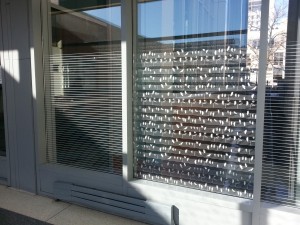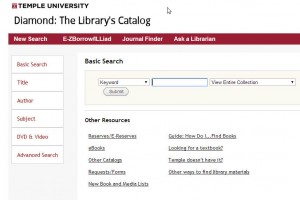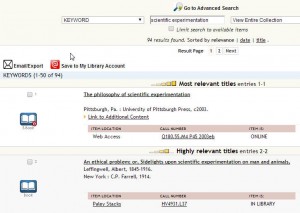As a kick-off for Archives Month Philly, Paley Library hosted “Live from the Collections: In and Out of Poetry” Tuesday, October 1st. Stemming from an exhibition of small press and alternative poetry entitled “The Fun in Speaking English” done by TU Libraries in spring, the afternoon saw the assembly of three poets who, through their own work’s thematic concerns and by their very participation in the event of the reading, interrogate and explore the notion of The Archive. Challenging the audience to consider the reading as more than a recitation of poetic product, Moderator Matthew Kalasky (director of Philadelphia cultural organization Nicola Midnight St. Claire) prefaced the reading by posing the question, “How does the current reading color the writing process of the past?”
The reading began with Penn Ph.D. student/writer/media archivist Daniel Snelson sharing work exploring the infinitude of the poetic page. Snelson read from Ronald Johnson’s Radi O’s, a poem which, through the careful, meticulous removal of text from Milton’s Paradise Lost, recontextualizes and reinvents the work. Snelson then shared one of his own projects of reimagining, audio of himself reading over archived audio of a reading by poet Rosmarie Waldrop of her work Differences for Four Hands reading over audio of a previous reading of her poem. Yes, you did in fact read that correctly: note the layers! Waldrop’s last stanza in particular, speaks toward the process & performance theme of the reading:
“Clara, play for us. The performance over, your name drops back out of the air. Records now, of course. Groove dreams whipped stiff. You never stepped twice…”
Next, the program featured prolific contemporary poet Lyn Lifshin, a writer whose work is partially housed in TU Libraries’ Special Collections Research Center (check out the extensive list of the Library’s holdings here). Plumbing her own archive of material, Lifshin read a number of poems, sometimes pausing between each to give the audience a history of the poem, in terms of both its initial writing and its life as a performed piece. The following piece, the beautiful and devastating “I Remember Being Lovely But,” was one of these historicized poems, allowing the audience a glimpse into the moments of its creation. The work itself functions as the poeticized written trace of lived experience, each performance of the work a further instance of documentation:
“There were snakes in the
tent. My mother was
strong but she never
slept, was afraid of
dreaming. In Auschwitz
there was a numbness,
lull of just staying
alive. Her two babies
gassed before her, Dr.
Mengele. Do you know
who he is? She kept
her young sister alive
only to have her die
in her arms the night
of liberation. My mother
is big-boned but she
weighed under 80 lbs.
It was hot. I thought
the snakes lovely. No
drugs in Israel, no
food. I got pneumonia,
my mother knocked the
doctor to the floor
when they refused,
said I lost two in
the camp and if this
one dies I’ll kill
myself in front of you.
I thought that once
you became a mother
blue numbers appeared
mysteriously, tattooed
on your wrist.”
The SCRC also contains a substantial amount of Lifshin’s papers, including poem drafts and correspondences.
Poet Elaine Terranova ended the afternoon’s readings, reading from several of her seven collections of poetry. (Some of Terranova’s work is housed in the SCRC–see the list here). Her poem “Stairway”, from her most recent collection Dollhouse, nicely summates many of the tensions of the archive:
“Think of the dollhouse
as a collection, a museum,
even a prison, but a little doll,
a tiny chair, mean nothing
if not in the context of a house.
There is in a house, despite
its safety, I don’t know,
such capacity for movement and change.
At night, for instance, a house
talks back, crackles and knocks.
Turn on the alarm and it is like
setting the alarm of your fear,
little birdcall of eternity.
Downstairs you have only just
shut the door on the world
and you float up, giddy with sleep.
You fly–don’t they call the sets
of steps flights? At the top,
massive dark, a wind that rushes through the hall.
Everything moves around.
Nothing is stable. Then you open
a door, look through a window,
and find there, pocketed by the sky,
the nearly perfect moon.”
Terranova reminds us, “Nothing is stable”, and such is the archive, not merely a static collection of printed texts “whipped stiff”, to borrow from Waldrop, but an animate entity that circulates beyond its physical repository, full of a “capacity for movement and change,” each performance a circuit on a current that loops both backward and forward. The works shared by these three wonderful poets that afternoon were indeed dreams grooved and regrooved, each performance an instance of truly moving beyond the page, renegotiating the boundaries of the printed word.

Poet Daniel Snelson explicates his poetic process to the audience while Moderator Matthew Kalasky and poets Lyn Lifshin and Elaine Terranova look on.
Interested in future library programming? Take a look at this calendar for the Beyond the Page schedule of events.





